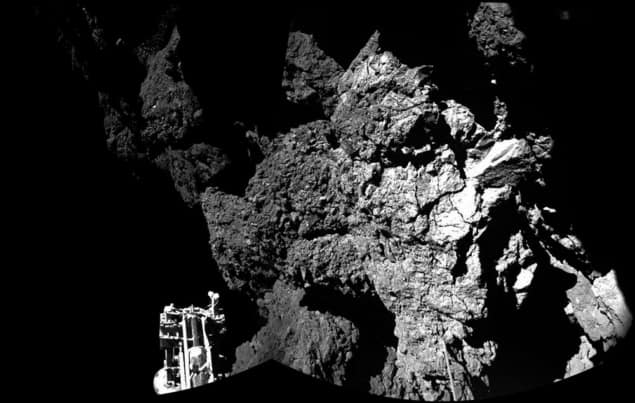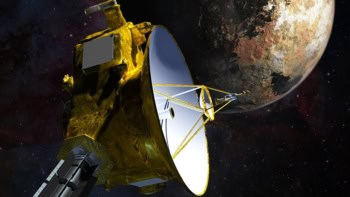With the Physics World 2019 Breakthrough of the Year due to be announced on 12 December, Physics World journalists look back at the past decade of winners and explore how research in that field has moved on. Here Margaret Harris reflects on the 2014 breakthrough, which went to the European Space Agency’s Rosetta mission “for landing a spacecraft on a comet”

Landing stuff on other worlds is hard. Just ask the people behind the Vikram lunar lander, which crashed onto the Moon in September 2019; or the Beresheet lunar lander, which met a similar fate in April; or the Mars Polar Lander, or the Beagle 2, or – well, you get the picture.
So when a little craft called Philae descended towards the comet 67P/Churyumov–Gerasimenko, touched down briefly, bounced off the surface, landed, bounced again, and finally came to rest on this 4.1km by 4.3km chunk of interplanetary ice, we thought it was quite an accomplishment. A month later, the ESA team behind the Philae lander and its parent Rosetta mission won Physics World’s 2014 “Breakthrough of the Year” for making the first non-destructive landing of a spacecraft on a comet nucleus.
In hindsight, Philae’s survival was something of a lucky accident. The harpoon that was meant to secure it to 67P/Churyumov–Gerasimenko failed to fire. A set of thrusters designed to push it onto the comet didn’t work either. And when the craft finally came to rest, it was in an awkward location, stuck on its side in a dark crevice that prevented its solar panels from functioning and made communication a challenge.
Fortune favours the well-prepared, though, and the ESA team made the most of Philae’s 57-hour operational life, gathering reams of scientific data from a suite of onboard instruments before the probe’s batteries failed. Among other achievements, Philae sniffed out organic molecules on the comet’s surface and discovered that the material in its immediate vicinity was much harder than expected. Studies of the comet’s deuterium-to-hydrogen ratio also lent support to the theory that asteroids, rather than comets, brought water to Earth – an important contribution to our understanding of the early solar system.
Missions like Rosetta don’t come along very often, so it’s not surprising that no-one else has landed on a comet since 2014 (or tried to). But the success of ESA’s lander fired imaginations and fuelled an interest in the solar system’s smaller objects that continues today. Just last week, NASA’s OSIRIS-REx mission announced a series of discoveries about particle ejections from an asteroid called Bennu. Over the summer, another spacecraft, Hayabusa-2, scooped up samples from the asteroid 162173 Ryugu. Hayabusa-2’s samples are now on their way back to Earth, and towards the end of 2020, scientists at JAXA, the Japanese space agency, will have their own nerve-wracking moment when they attempt to retrieve them.
Perhaps the most intriguing development in this field came in October 2017 with the unexpected arrival of a small, irregularly-shaped object known as ‘Oumuamua. Initially designated as a comet, and later reclassed as an asteroid, ‘Oumuamua is now thought to be neither. Instead, it is an interstellar visitor – the name ‘Oumuamua means “scout” in Hawaiian – and its exact composition is a matter of much scientific debate (as well as endless science-fiction-driven speculation). A craft like Philae or Hayabusa could answer those questions, and a group of scientists at a non-profit organization, the Institute for Interstellar Studies (IIS), has duly proposed a rendezvous mission to ‘Oumuamua.
Most space missions take a while to get off the ground, and with ‘Oumuamua already on its way out of the solar system, the odds seem stacked against the IIS scientists. But other, similar missions are also under development. One of them, ESA’s Comet Interceptor, is designed to visit a comet or interstellar visitor that hasn’t even been discovered yet. According to Geraint Jones, a planetary scientist at University College London and co-leader of the team that proposed the mission, the idea is to place the spacecraft in a dynamically-stable location (the L2 Lagrange point of the Earth-Sun system), wait until a suitable object comes along, then send the craft to investigate it. Something like ‘Oumuamua would be ideal, but a long-period comet full of relatively pristine “leftovers” from when the planets formed would also tell us much about the early history of our solar system.
The launch date for Comet Interceptor isn’t until 2028, so it’ll be a while before we can enjoy a sequel to the comet-exploring achievements of 2014. As Philae and the Rosetta mission showed, though, some things are worth the wait.



